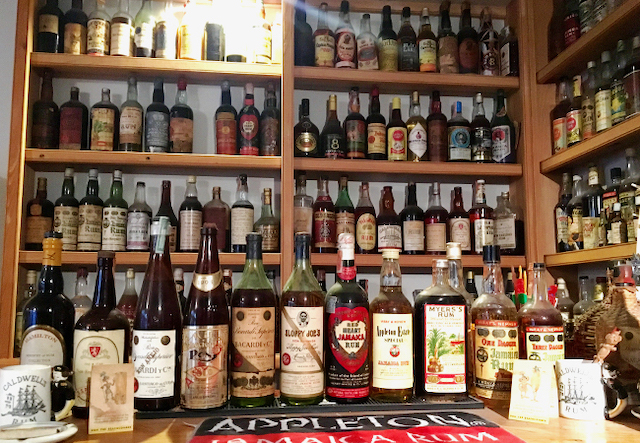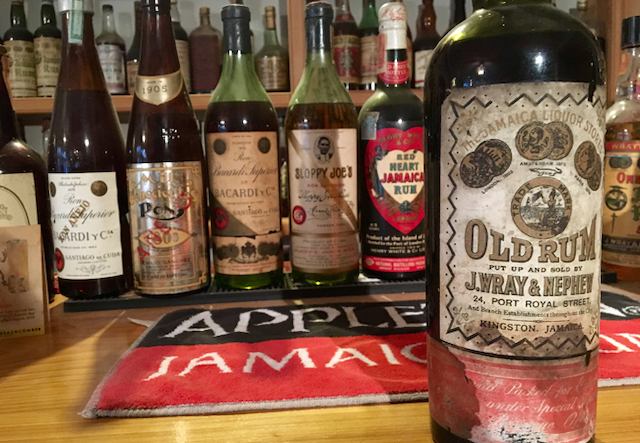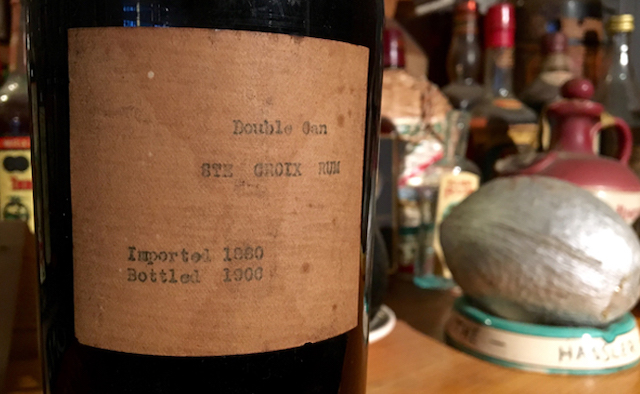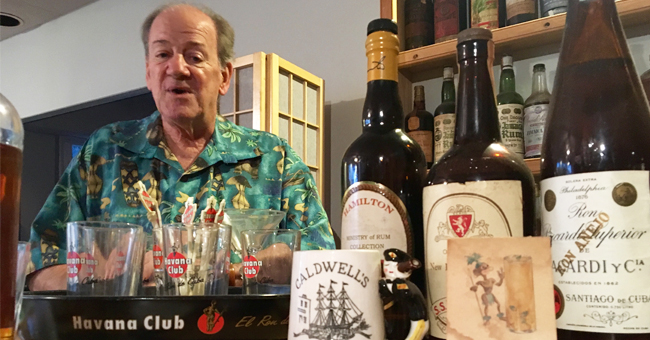Steve Remsberg has a bit of an obsession: over four decades, he’s collected over 1,000 bottles of rum. In fact, Steve remodeled his downstairs Broodmore house around his rum collection. Like an action figure fanatic who keeps his treasures unopened in the original packaging, Remsberg’s rum display features almost all unopened bottles of rum — but that doesn’t mean he doesn’t dip into his own supply. (He’s been lucky enough to find duplicates.) The unopened bottles are for display, but he pulls out the opened ones for sipping with special guests, especially during Tales of the Cocktail. We recently had the pleasure of sitting at Remsberg’s custom-made bar and having a fluid conversation about the object of his affection.
So many people say they “don’t do rum.” Why do you think that is?
Rum has a lingering bad reputation from the practices of numerous liquor store owners in the late 1930s. After Prohibition was repealed, there was very little whiskey for sale in the United States, but there was an awful lot of rum just sitting dockside in the Caribbean, and it flooded the market. The store owners would make you buy a case of rum – which was very cheap, but often undesired – in order to buy a good quart of whiskey. I think in many ways that bitterness has persisted.
Maybe it is that so many people are exposed to bad rum that they don’t appreciate good rum?
Nobody starts out sipping extraordinary rum. They start out with the light rums in this country that come from Puerto Rico or the Virgin Islands and they drink them in poorly made cocktails. They drink rum in sweet carbonated beverages, it ends up being too sweet for their taste and they blame it on the rum. If the rum is well made, all the natural sugar is converted to alcohol. Now, nobody realizes that. They say, “Rum is made from sugar, so what do you expect?”
One of the bad things that’s been happening recently, rogue shippers of rum are having sugar added to the barrel before they are emptied into the bottle. At least spiced rum is labeled with additives. There are a lot of sins that have crept into the industry that would be eliminated with proper labeling.
 Remsberg keeps many of the bottles in his “permanent collection” unopened, but he’s been able to track down duplicates for tasting and sharing.
Remsberg keeps many of the bottles in his “permanent collection” unopened, but he’s been able to track down duplicates for tasting and sharing.
How did you first encounter rum?
Well, when I was in college I lived in a city, Washington D.C., that had one of the classic Polynesian-style tiki bars and a very high quality branch of the Trader Vic’s chain. Oh, man, when I discovered that, I thought I had found heaven. But the problem was as a student, you can’t afford to drink that kind of stuff often. And the recipes were a trade secret. But if you were really industrious, and I was at the time, you found a few of the recipes were accessible. As years went by, it became more so. Finally Trader Vic, by the time he wrote his fifth recipe book, had spilled out all his recipes.
I loved the drinks, so I was buying rum to replicate them at home as best I could. What I discovered over time, as more information about the recipes was revealed, I realized that the flavoring syrups and the fruit juices weren’t making the difference in drink – it was the caliber of rums. Once you get above the really inexpensive light rums, you find rum has incredible and varied flavor. So that told me, I can’t just buy one bottle of rum anymore, I’m going to need six. And then I needed 15 different types of rum to make all the drinks properly and I just went from there.
It’s exciting that all across the country you see more and more tiki bars popping up. Even in regular bars you’re seeing hints of it. My local bar, the Black Penny in the French Quarter, is known for their vast beer selection — but there’s a fantastic bartender, John Peterson, that makes his own orgeat. Right there in my little corner bar, I can enjoy one the best Mai Tais I’ve ever had.
That’s the whole point of this craft cocktail movement. These people are so fanatical about authenticity and everything has to be completely natural. I know Jeff “Beachbum” Berry, his nightmare in anticipation of opening Latitude 29 was that some fool would accuse him of using high fructose corn syrup, meanwhile he’s hard at work hand-brewing his own simple syrups made of all different types of sugar. If he was using anything artificial, the craft cocktail people would turn on him like sharks smelling blood in the water. But that didn’t happen.rn
Is that your favorite tiki bar in New Orleans, Latitude 29?
Oh yeah.
Some people say that Cane & Table is their favorite tiki bar, but to me it feels less tiki and more a bar you would find in Havana.
Cane & Table has a very good rum selection and also the Rum House in New Orleans has a phenomenal collection of rum. It’s a great place if you are into rums you could make an evening out of stopping there. Cure also has a shelf full of rum. All these people are fanatics. One thing that’s boosted me, early on — pre-internet — I connected with Dr. Cocktail, Ted Haigh, who wrote the book “Vintage Spirits and Forgotten Cocktails,” which I feel provoked the craft cocktail movement. If you look in his glossaries he’ll tell you where to get herbs by mail order that you’ve never heard of.
Have you traveled to Cuba?
No. One of my closest friends in New York was a Cuban immigrant, but his family had a pretty tough time after the revolution. His family had lost everything and suffered considerable hardship. Now I probably haven’t laid eyes on this guy in seven or eight years, but I wouldn’t be able to look him in the eye and tell him that I went down there and spent my hard-earned money supporting the Castro regime.
How do you think the rum market is going to change when Cuba opens up and everyone can get Havana Club?
It will be time enough coming, won’t it? The Cuban rum industry is effectively owned by Pernod Ricard, an absinthe maker in France. They’ll ramp up the production. In the 1990s — and you can taste the difference — the French took over the marketing and the demand for Havana Club outpaced the supply, but they were so starved for foreign currency that they bottled what they could anyway. There was definitely a period where the top of the line seven year anejo was not aged for seven years and the best rum that Havana Club had was their 5 year, which is still my favorite of the old early Castro Havana Club labels.
I’m a real believer that a rising tide raises all ships, so my hope is that all those people that say they are not rum drinkers may be curious enough to try Cuban rum and discover other rums that way.
It will spark the market. Just like the resurrection of the tiki bar craze has done.
 Jamaican distiller Wray & Nephew is a favorite of Remsberg’s—he owns every bottle of aged rum they’ve ever made.
Jamaican distiller Wray & Nephew is a favorite of Remsberg’s—he owns every bottle of aged rum they’ve ever made.
What is your favorite rum destination?
Oh, it used to be Jamaica. The first five years I was working and could afford a real vacation, I spent them all in Jamaica. And there I picked up a lot of wonderful bottles of rum that quickly became discontinued. They were just on the shelves of these small, rural grocery stores.
Do you have a favorite distillery there?
Well, the big dog, even back in the 1970s, was Wray and Nephew. They were starting to buy up all the smaller producers. My favorite rums were theirs.
I see some rums on your bar from 1905. What is your oldest rum?
This one from St. Croix, or as the old books would call it, Santa Cruz, and it’s from 1860. That’s when it was made, but it was bottled in 1906.
I notice a lot of your bottles haven’t been opened.
I call this my permanent collection. Most of the bottles displayed are unopened. Maybe a handful are, but no more than five or six. But I’ve always had good luck for finding bottles, even the very old ones, that are unopened. What’s the purpose of looking at empty bottles? If a collection has any purpose at all, it’s to show how rums of a certain origin or a certain producer have evolved over the years. For instance, I have every bottle of aged rum that Wray and Nephew ever made.
I practically have to beat people off the front stoop during Tales of the Cocktail. You meet people and they always want to see the collection. When I host people, especially during Tales, I do open my duplicates.
It seems to me gin had its day a few years back. Is this rum’s time?
Oh, it’s booming. This is the best market for rum in the United States since the 1930s.
If you were out for an evening cocktail, what would you order?
I probably would get one of the two older Appleton rums from Jamaica. The Appleton 12-year-old.
Do you have a favorite mixed drink?
The old-style Jamaican Planter’s Punch. And if I find somebody who makes a good one, that’s what I’ll drink. It has to be with freshly squeezed juice. I remember going to Bar Tonique when it opened, I got their version of a Dark and Stormy. Instead of reaching for a bottle of organic ginger beer, the guy gets out a couple of little squeeze bottles filled with homemade sweeteners and fresh-pressed ginger. Then he tops it with soda water, which they probably make themselves and I remember laughing and thinking, “Ok. I’ll go with this.”
Steve, I could talk to you for days about rum, but I’ll let you get back to your evening. Any parting words?
“I feel sorry for people who don’t drink, because when they wake up in the morning that’s the best they’re going to feel all day.” That’s my favorite quote by Frank Sinatra. He was a Jack Daniel’s drinker, but you can’t hold that against him.

One of Remsberg’s crown jewels is this St. Croix rum, the oldest bottle in the collection: it was produced in 1860 and bottled in 1906.





